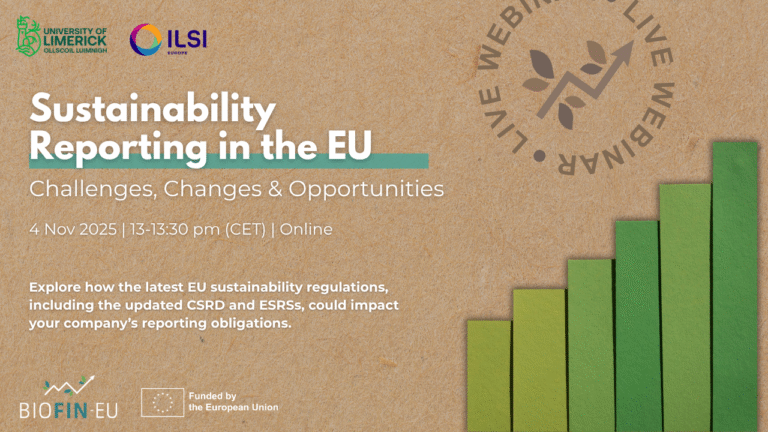Nature is essential for human life, and our society depends directly and indirectly on biodiversity and ecosystem services. However, the global financial system prioritizes profit over environmental impact, contributing to biodiversity loss and bringing our biosphere closer to collapse. The financial system is made up of institutions and intermediaries that use tools that direct and redirect the flow of capital. The EU Sustainable Finance Taxonomy (SFT) provides an important starting point to limit harmful financial practices and redirect investments toward nature-positive activities.
But what is the EU Taxonomy and why do we need it?
The EU Taxonomy (entered into force on 12 July 2020) is a key tool in the EU’s plan for sustainable finance. It helps direct investments toward activities that support the green transition. This system sets clear rules for what counts as environmentally sustainable, aiming for a net-zero future by 2050 and other environmental goals.
What the EU Taxonomy is
- A classification system to establish clear definitions of what is an environmentally sustainable economic activity
- A tool to help investors and companies decide how environmentally sustainable an investment is
- The Taxonomy will be updated regularly to keep up with technology and policy developments
- Helping polluting sectors shift to cleaner practices
- Technology neutral
- Ensuring transparency through required disclosures by financial markets and large companies
What the EU Taxonomy is not
- It is not a mandatory list to invest in
- It is not a rating of the “greenness” of companies
- It does not assess the financial performance of an investment
- Just because an activity isn’t listed doesn’t mean it’s harmful. The focus is on activities that significantly support environmental goals
Reliable tools are needed to help companies transition to climate neutrality and a sustainable economy. The EU Taxonomy is one such tool, providing clear criteria for green activities and establishing a common language for businesses and investors. It helps companies plan and finance their transition, reduces market fragmentation, prevents greenwashing, and speeds up investment in both existing and transitioning sustainable projects. As part of a larger sustainable finance framework, the EU Taxonomy plays a key role in scaling up investments in green projects needed to achieve the European Green Deal‘s goals.
Structure of the EU Taxonomy
To meet the EU’s 2030 climate and energy targets It is important to invest in sustainable projects
Structure of the EU Taxonomy
Structure of the EU Taxonomy
The EU Taxonomy is organized into several key components that define its operation:
01. Environmental Objectives
The taxonomy identifies six environmental objectives that guide the classification of economic activities. Each objective is aimed at addressing specific environmental challenges:

Climate Change Mitigation
Activities that contribute to reducing greenhouse gas emissions

Climate Change Adaptation
Activities that enhance resilience to climate change impacts

Sustainable Use and Protection of Water and Marine Resources
Activities that promote sustainable water management and protect aquatic ecosystems

Transition to a Circular Economy
Activities that minimize waste and promote resource efficiency through recycling and reuse

Pollution Prevention and Control
Activities aimed at reducing pollution in air, water, and soil

Protection and Restoration of Biodiversity and Ecosystems
Activities that conserve biodiversity and restore degraded ecosystems
02. Technical Screening Criteria
For each economic activity categorised under the taxonomy, specific technical criteria have been developed to determine whether it significantly contributes to one or more of the environmental objectives. These criteria are based on scientific evidence and best practices.
03. Do No Significant Harm (DNSH) Principle
An activity must not significantly harm any of the other five environmental objectives while contributing to one. This principle ensures a holistic approach to sustainability.
04. Minimum Safeguards
The taxonomy also requires compliance with minimum social safeguards, including adherence to human rights standards and labor rights.
Implications for Stakeholders
The EU Taxonomy has significant implications for various stakeholders:
Investors
The taxonomy provides investors with a clear framework for identifying sustainable investments, reducing uncertainty in the market. It helps them make informed decisions about where to allocate capital based on sustainability criteria.
Companies
Businesses are encouraged to align their operations with the taxonomy’s criteria to attract investment and enhance their sustainability profiles. Companies that can demonstrate compliance may benefit from increased access to green financing and improved reputational standing.
Financial Institutions
Banks and financial institutions are expected to integrate the taxonomy into their lending practices and investment strategies. This may involve adjusting their risk assessment frameworks to account for environmental sustainability.
Regulators and Policymakers
The taxonomy serves as a tool for regulators to promote sustainable finance initiatives and track progress toward environmental goals at both national and EU levels.
The EU Taxonomy represents a comprehensive effort by the EU to create a standardized framework for sustainable finance. By categorizing economic activities based on their environmental impact, it aims to mobilize investments towards projects that contribute positively to climate goals while ensuring accountability among businesses.
The BIOFIN-EU project focuses on unlocking financial flows, essential for protecting and reversing biodiversity loss, supporting the EU Sustainable Finance Taxonomy (SFT), towards achieving EU 2050 climate goals. The project paves the way for transformative changes through Nature-Based Solutions (NBS), addressing barriers and gaps in implementing the SFT and providing guidance, training, and tools for supporting decision-making for NBS investments.






